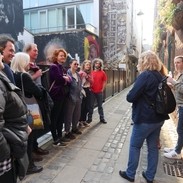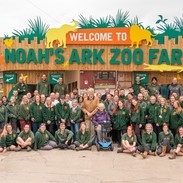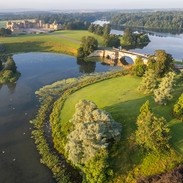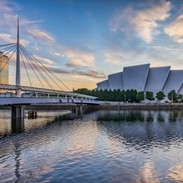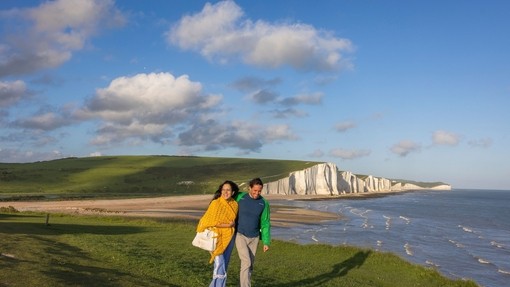
Experience screen magic in East Sussex, Buckinghamshire, and Norfolk
The Seven Sisters Country Park, home to a series of chalk cliffs along the Sussex Heritage Coast, takes centre stage in the opening scene of Wicked. This landscape provides the backdrop for Glinda’s arrival at Shiz University in a pink sailboat, filmed along the Cuckmere River within the park. This scenic setting is a designated Area of Outstanding Natural Beauty (AONB), and its scenic trails offer far-reaching views across the English Channel. Visitors can explore the park’s coastline, enjoy birdwatching, or take a walk to Beachy Head, the highest chalk sea cliff in Britain.
Meanwhile, the village of Ivinghoe, near Luton, was transformed into Munchkinland, featuring colourful cottages and the iconic Yellow Brick Road. Ivinghoe has plenty to offer visitors beyond its connection to the film. A part of the Chiltern Hills, Ivinghoe Beacon offers stunning panoramic views and marks the start of the Ridgeway National Trail. Waddesdon Manor, a short drive from Ivinghoe, is a French Renaissance-style château famed for its opulent interiors, art collection and landscaped gardens, as well as its appearances in The Crown, Queen Charlotte, and Cinderella (2021). With a history dating back to the late 19th century, the estate’s beautifully restored rooms and extensive grounds make it a prime destination for history lovers and film buffs alike.
Tulip fields near King’s Lynn in Norfolk bring colour to the big screen, representing the vibrant and whimsical elements of Wicked. Belmont Nurseries, the UK’s largest tulip grower, cultivated nine million tulips specifically for the film, transforming their fields into a kaleidoscope of hues that helped bring Munchkinland to life. Each spring, the fields are open to visitors, who can walk among the rows of tulips and explore the 20-acre nursery, which grows more than 100 different varieties. The floral displays are viewable for a limited time, before the tulips are then harvested for sale.
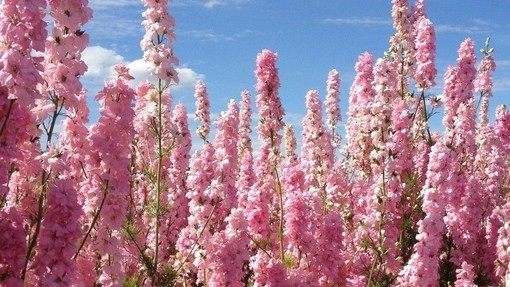
Floral fantasies: Explore Britain’s blooming marvels
For those enchanted by the floral landscapes in Wicked, Britain offers a spectacular array of flower-filled experiences, each displaying a unique set of colours and scents. From vibrant tulip fields and sunflower meadows to enchanting bluebell woods and golden daffodil landscapes, Britain offers fairy tale escapes to match the on-screen magic.
In West Sussex, Tulip Fest (5 to 27 April 2025) at Arundel Castle sees more than 120,000 tulips bloom across its historic gardens, transforming the site into a sea of colourful flowers. The castle’s carefully curated displays, set against its medieval backdrop, make this a memorable spectacle each spring. As part of the event, the Arundel Castle Gardens are open to the public for an extended period, giving visitors the chance to explore its 16-acre gardens, which also feature rare plants and topiary.
Alternatively, the Confetti Flower Field in Wick, Worcestershire, opens for just a few weeks in late June and early July, revealing acres of delphiniums in shades of blue, pink and purple. Nestled within the Wyke Manor Estate, these fields are not only a dreamlike setting for photographers, but also a source of natural petal confetti, handpicked and dried for weddings and other celebrations.
For those who prefer strolling through woodlands, Badbury Hill in Oxfordshire bursts into life from late April to early May, with a carpet of bluebells beneath beech trees. This National Trust site offers a captivating display, as sunlight filters through the leaves illuminating the bluebells below. Similarly, Micheldever Woods in Hampshire provides another bluebell haven in spring, when the forest floor is transformed into a sea of blue.
Summer brings a golden glow to Rhossili in Wales, where fields of sunflowers stretch towards the sky from July onwards. Planted on National Trust land at Rhossili Farm, these sunflowers bloom for a few weeks each summer, giving visitors an opportunity to walk among the rows of towering plants. Overlooking the coastline of the Gower Peninsula, the UK’s first designated Area of Outstanding Natural Beauty, the sunflower fields provide an idyllic setting for long walks, accompanied by panoramic views across Rhossili Bay. While here, visitors can also explore Worm’s Head, a tidal island brimming with wildlife, including seals and seabirds, or follow the coastal path to the remains of the Helvetia shipwreck, hidden beneath the sand and viewable at low tide.
Scotland also celebrates spring in spectacular style at Brodie Castle in Forres, where thousands of daffodils bloom across the historic estate each April. Among them is the rare Brodie daffodil, a unique variety cultivated by Ian Brodie, 24th Laird of Brodie in the 19th century. Visitors can stroll through the castle gardens before exploring the 18th century castle, home to the Brodie family for more than 400 years. Beyond the daffodils, the estate’s woodlands and walled garden provide a backdrop for a peaceful day out, while the historic town of Forres offers access to the Findhorn Bay Nature Reserve and miles of scenic walking trails.

Fairy tale castles: Step into storybook settings
Britain’s landscapes are dotted with castles that could be lifted straight from the pages of a storybook like the Wizard of Oz. Many of these architectural marvels have also had starring roles in film and television productions, mixing history with cinematic intrigue.
In England, Hever Castle in the heart of Kent is renowned not just for its fairy tale appearance, but also for its historical ties – it was the childhood home of Anne Boleyn, the second wife of King Henry VIII. Its picturesque moat, Tudor-style interiors, and award-winning gardens have made it a popular filming location for period dramas, including The Other Boleyn Girl. Visitors can explore its lavish rooms, admire centuries-old tapestries, and wander through the Italian Garden, which bursts into colour when 4,000 rose bushes bloom each summer. For a truly immersive experience, stay overnight in Hever Castle’s own bed and breakfast in the Astor Wing or the Anne Boleyn Wing. In Northumberland, Alnwick Castle will be recognisable to fans as Hogwarts from the Harry Potter films. Beyond its magical reputation, it boasts an impressive history dating back to the Norman period. Visitors can take part in broomstick training sessions, wander through its luxurious state rooms, or explore the enchanting Alnwick Garden. Alongside carefully manicured greenery, it is also home to a Poison Garden filled with toxic plants, which can only be viewed on guided tours.
In Scotland, Dunrobin Castle in Sutherland, a 15-minute drive from Dornoch, is one of Britain’s oldest continuously inhabited castles, with fairy tale spires and turrets resembling a French château. Overlooking the Moray Firth, the castle’s interiors are equally dazzling, with ornate ceilings and antique furniture. For those drawn to dramatic cinematic settings, Eilean Donan Castle in the Scottish Highlands will not disappoint. Perched on a small island at the meeting point of three lochs, it has appeared in Highlander and James Bond: The World Is Not Enough. The castle, originally built in the 13th century, offers visitors the chance to walk through ancient stone halls, explore its battlements, and take in sweeping views of the surrounding mountains.
Wales, too, has its own fairy tale fortress in Castell Coch, near Cardiff. This 19th century Gothic Revival castle, with its conical towers and lavishly decorated interiors, has provided the setting for numerous productions, including Doctor Who. In the north of the country, Conwy Castle is a striking medieval stronghold with dramatic battlements and an imposing riverside location. Built by King Edward I in the late 13th century, the castle is a UNESCO World Heritage Site – alongside Edward’s other castles at Beaumaris, Harlech and Caernarfon – and is considered one of the finest examples of military architecture from its era. With its towering turrets and well-preserved great hall, it transports visitors back to the days of knights, sieges, and medieval warfare.


